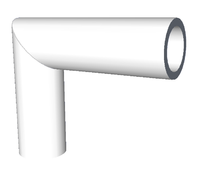Bamboo Construction Guide
Bamboo is a unique material and working with it has been a trial and error process. Here are some of our findings from Lab.
Cutting Bamboo –
Bamboo poles can be cut by hand using a hacksaw. The bamboo can split and splinter at the end of the cut, so care must be taken in slowing down and carefully cutting at the end of the cut.
Power tools can also be used to cut bamboo. A bandsaw makes for a very clean cut and can cut along angles. Feeding round stock such as bamboo into a bandsaw should be done with care as the pole can kickback if it is fed to quickly.
Bamboo in a Vice –
| Figure 1 |
If cutting or drilling on a round piece of bamboo a vee block (Figure 1) and vice should be used so that that there are three points of contact preventing the bamboo from moving. Most bamboo is not perfectly stright and when put in a vice the load is highly concentrated on small contact areas. Wrapping the bamboo in a piece of fabric can help to better distribute the load, but care should be taken when tightening a vice as it is easy to crack and split a rod.
Mitering Bamboo –
Mitering is the process of cutting two pieces of bamboo on a bevel so that the fit snugly together. See the images below for examples of miter joints.
 |
| Figure 1 |
| Figure 2 |
| Figure 3 |
| Figure 4 |
For joints such as Figure 1, two bamboo poles are cut at an angle using either a hand saw or power saw. A disc sander or sanding block can be used to get the exact angle desired and to be sure both rods have maximum contact for transferring loads.
For joints such as Figure 2 and Figure 3, a hole saw (Figure 4) on a drill press makes clean cuts. A backing block should be used to prevent the bamboo from splintering during the cut. A hacksaw can also be used to cut a “V” shaped section out of the rod. Filing or chiseling along with sanding (either by hand or with a spindle sander) can be used get a snug fit between the poles.
Joining Bamboo –
We experimented with a number of different joint designs. Below our efforts and what we learned from each one.
 A) |
B) |
 C) |
 D) |
A) Pin Type Joint Perpendicular
- perpendicular pieces, small pin to secure pieces together
- positive: no twine/rope
- negative: little piece broke, not very sturdy
B) Lashing
- cross pieces and tie with twine
- positive: no power tools necessary
- negative: difficult to tie tight
C) Friction-Tight Hole Tie Connection
- second piece filed for positive fitting & attaches and extends outward from first piece
- positive: easy to tie tight, flush fit, vertical support
- negative: needs twine, power tools, and a file. Weak horizontally
D) Positive Fitting Rope Connection —runs through bamboo
- (puzzle piece like) each piece runs through another bamboo piece
- positive: most secure method out of the 4 joints
- negative: smaller piece can twist and turn, not a tight fit, power tools needed, and appropriate corresponding pieces (puzzle)
